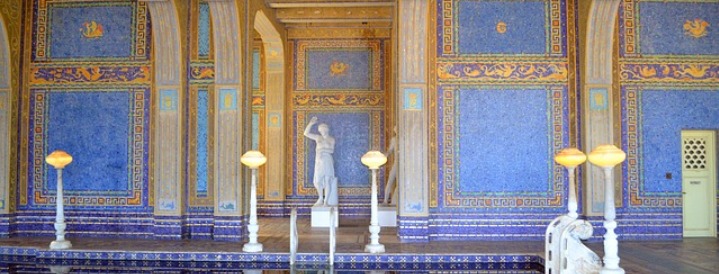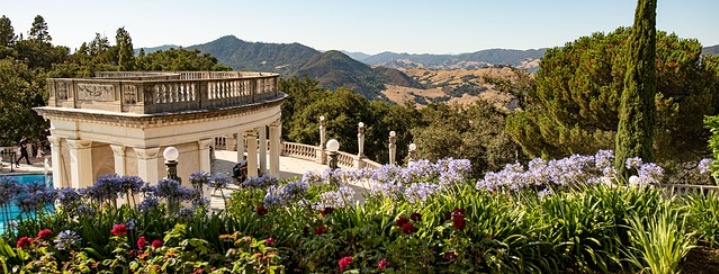Like many Californians, I skipped past Hearst Castle for years. I’d seen Orson Welles’s 1941 classic, Citizen Kane, and figured I knew all I needed to about Citizen Hearst and his San Simeon monument to self-indulgence. Fifty-six bedrooms, 61 baths, 41 fireplaces—the scale alone is embarrassing. It apparently took a village to house this man, who had the wealth of a Medici and the ego of Nero.
But the character behind his Mediterranean revival spectacle was also peculiarly American and, more particularly, Californian. The concrete confection, more than 71,000 square feet of buildings, cost William Randolph Hearst $4.7 million to construct between 1919 and 1947. And that’s before he stuffed the place with Spanish ceilings, Greek vases, Mexican saddles, French beds—and so, so much more. No modern gewgaw or ancient tchotchke was too expensive or insignificant to escape Hearst’s checkbook if it drew his eye.
Most visitors are astounded by what they find: Hearst wasn’t just rich, he had a sense of humor and was never afraid to mix classics with kitsch, the sacred with the oh-so-secular. Sure, he had two swimming pools, one edged with Roman marble columns, the other lined with Venetian glass and real gold. But the sculpted Grecian nymphs standing guard over his marble outdoor pool sport bobbed flapper hairdos. The intricately carved bathroom doors in one suite originally graced a cathedral’s sacristy.

Every room in this playhouse—part museum, part hunting lodge—is a bit of history, frozen in time. In Hearst’s medieval dining hall, or “Refectory,” the long, narrow table is set for dinner with antique silver and extra ketchup. Nearby, almost invisible in the elaborate parlor, is a little card table where Hearst’s beloved mistress, film star Marion Davies, worked jigsaw puzzles with gossip columnist Hedda Hopper. Around the corner is the billiard room where actress Carole Lombard batted her eyelashes, chalked her cue stick, and beat every man foolish enough to challenge her to a game.
Born in 1863, Hearst was a native San Franciscan who transformed the millions milked from the family silver mines into publishing gold. By the time he first laid plans for the Castle on the ridge of a favorite childhood campsite 90 miles south of Monterey, W.R. was 56 years old. He had already gobbled three or four lifetimes’ worth of adventures and was hungry for more. Hearst was a Harvard dropout with a voracious lust for antiquities. He had a society wife and five sons, but he lived openly for 30 years with a mistress 35 years his junior. He was a tycoon who’d begged money from his mother, a large man with a tinny voice, a presidential hopeful who dreaded public speaking. He was a populist who loved animals more than people, a founding father of tabloid journalism who banned sex and scandal from his movies.
Homes to Hearst (and he had several) were all spectacular themed sets where he could stash his treasures, wow guests, and gather cronies to plot his next business or political move. His father, George, another man of stubbornly outsize appetites, once wrote of young Will, “When he wants cake, he wants cake and he wants it now. I have noticed that, after a while, he gets the cake.”
During my weekend trip to Hearst Castle, I looked up Wilfred Lyons, now 90 years old and historian emeritus of the nearby village of Cambria. In the 1930s, when Lyons and his late wife were fresh-faced and affianced, both worked for Hearst at the Castle and had the time of their lives. “You have to understand,” Lyons said as he pulled out a photo album and settled into the story he loves to tell, “it was a different time.”

Lyons worked many of the parties over the years, crisp and tan in his bow tie and white jacket. Regulars in the 1930s included Clark Gable, Myrna Loy, Bing Crosby, Charlie Chaplin, Irving Thalberg, and Norma Shearer. “The movie people were always there,” Lyons says. “My favorite was Cary Grant. He stopped on a couple of occasions to visit at the gatehouse with us. We’d talk about the movies, life—everything. He was great fun.” Sometimes, apparently, too much fun; one day Grant nearly got himself kicked off the property permanently when he and Will Jr. took a small plane up above the estate and, as a prank, bombarded the hangar’s roof with sacks of flour. When they returned, Grant’s bags were packed and waiting for him by the front door—W.R.’s not-so-subtle signal to drunken or philandering or otherwise boorish guests that it was time to go.
“There was a lot of hanky-panky in those days,” Lyons reports, refusing to name names. “But Mr. Hearst was very strict. If you did something he didn’t like and he found out, you didn’t get invited back.” A glass or two of wine was served with dinner but cocktails were strictly rationed, probably to rein in Davies, a charming but determined alcoholic.
The staff addressed their employers deferentially as “Mr. Hearst” and “Miss Davies,” but otherwise the tone of the place was deliberately unpretentious, Lyons says, despite the gilt and glamour. Visitors and servants enjoyed the same lavish menus of ranch-reared steak and poultry or Alaskan salmon flown in fresh. Guests dined family-style with Hearst in his grand dining hall, using camp china, heavy antique silver, and paper napkins; they reached around crystal goblets to get to the ever-present mustard and ketchup bottles in the center of the table.
Nobody strayed far from the house at night. “It sounded like you were in Africa out there,” Lyons remembers. Hearst’s collection of carnivores, including lions, leopards, and polar bears, were kept in separate locked enclosures, but the less dangerous exotics, among them kangaroos and yaks, freely roamed the hills. (Remnants of the zebra herd can still be seen today, mingling with local Herefords.)

The compound was designed in every detail, from the bell tower to swimming pool ladders, by San Francisco architect Julia Morgan, in close collaboration with Hearst. As her client, Morgan was a demanding workaholic who lived on coffee and chocolate bars and spent 28 years of weekends overseeing construction at San Simeon. She kept busy in San Francisco during the week, designing at least 700 other buildings in her lifetime (see “Julia’s Other Castles,” page 43).
In Hearst’s mind, money was never a hurdle. When a 100-year-old oak stood in the way of one of his design whims, the tree was moved (at a cost of about $40,000), rather than destroyed; towers were demolished and rebuilt as the scale of the building expanded; swimming pools were ripped out and replaced twice. With all the comings and goings of animals, guests, workers, and priceless art, it’s no wonder, says Lyons, that the lord of the manor was sometimes testy.
One night, Lyons recalls, a driver was late getting back from Hollywood with a movie to be screened that evening. In his rush to deliver it, he nearly ran over Hearst’s cherished hound, Helen. “We heard W.R. yelling in his high voice, ‘You’re fired, you’re fired, you almost hit the dog,’ ” Lyons says. “Miss Davies was running along behind, saying, ‘You’re not fired, you’re not fired, keep doing what you were doing.’ ”
Davies was always the funny mollifier, Hearst’s true love, muse, and confidant. Of all the fictions mixed with facts in Citizen Kane, the one that reportedly cut Hearst deepest was the insinuation that Davies—thinly disguised in the movie as Kane’s second wife, a blond alcoholic—was devoid of talent and dependent on Hearst to prop up her career. Even Orson Welles said the opposite was true. “Marion Davies was one of the most delightfully accomplished comediennes in the whole history of the screen,” the director wrote in a 1975 foreword to Davies’s posthumously published memoir. “She would have been a star if Hearst had never happened.”
The man who could and did buy everything saved his Castle’s best view for himself. It’s the vista from his bedroom window of the roaring edge of the Western frontier, a dividing line of crashing waves and swirling foam where the Pacific flirts with the weathered hills. Hearst was a true son of the West, and even those who hate much of what he stood for have to admire his exuberance and undying faith in the future. “Many Easterners never clearly understood what made Pop and his fellow Westerners tick,” Will Hearst Jr. once wrote. “[His] America was yet to be discovered—land and people of incalculable hope amid endless horizons.”
Near the water’s edge in San Simeon, a coin-operated telescope allows curious commoners to view the king’s Castle. What most don’t realize is that Hearst was curious about them too, as he gazed out from his manor to the possibilities beyond.
